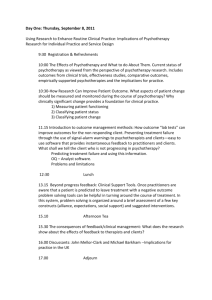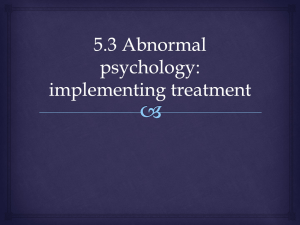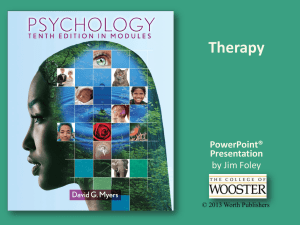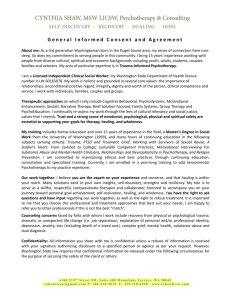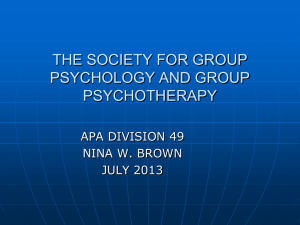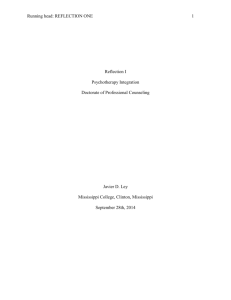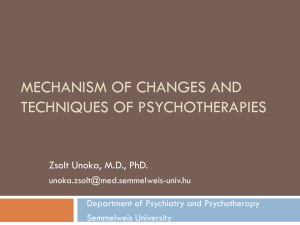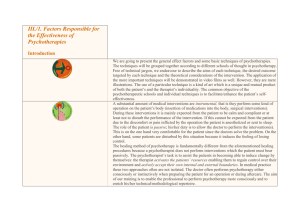joel
advertisement
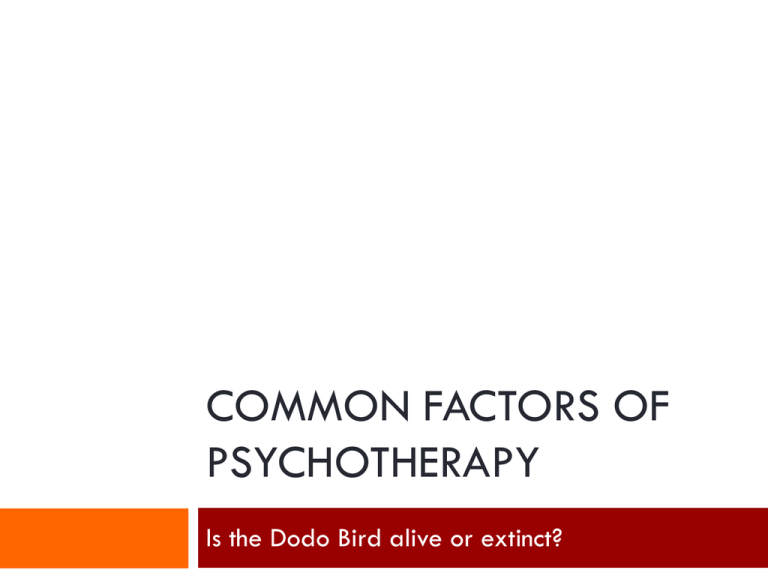
COMMON FACTORS OF PSYCHOTHERAPY Is the Dodo Bird alive or extinct? Come talk with me! Joel Thomas: jthoma11@illinois.edu Office hours: 2-3pm Tu/Th, Espresso Royale Café Travel, soccer, tennis, bass guitar Master’s in Counseling from UW-Madison, CounselingPsychology Department Interpersonal/Common Factors Training Research Interests: how and why psychotherapy works how psychotherapy compares with other cultural healing practices PhD student in Clinical/Community Psychology, UIUC Letting the path unfold! Reflection Exercise Peter is a single, 35-year-old Native American man who resides in an urban environment. Since graduating college with a degree in computer science, Peter has worked as an entry-level programmer, but he feels he is denied career opportunities because of racism and discrimination. Peter's job performance begins to deteriorate, and he experiences increasing feelings of depression. He begins to drink to numb feelings of worthlessness and extreme loneliness. Who would you recommend Peter see and why? A. Psychiatrist B. Traditional healer from the Native community C. Primary care doctor D. A good friend you know who has gone through a similar experience E. A counselor with whom you are familiar and who you trust Objectives for Today Explain findings of Consumer Reports Study (Seligman) Describe the Dodo Bird Effect Link the Dodo Bird Effect to the importance of common factors in psychotherapy (Wampold) Define and describe the 4 commonalities of healing practices in different cultures Seligman… M. E. P. Seligman, Consumer Reports Study (1995) Methodology 180,000 readers received issue, 7000 filled out survey, 3000 saw mental health professionals Educated, middle-class, 50% female, median age = 46 Outcome measures: Specific improvement Satisfaction Global Improvement Consumer Reports Study (Findings) Psychotherapy led to improvement for 90% Psychiatrists, psychologists, social workers equally effective Longer treatment led to better outcomes Limitations on insurance led to worse outcomes Consumer Reports Study (Findings) People who felt worst before treatment reported the most improvement No difference between different types of therapies No difference between psychotherapy alone and psychotherapy with meds Active shoppers and active clients did better Conclusion: Psychotherapy Works! Critique: non-random, self-report, no control groups, cognitive dissonance Dodo Bird effect "Everybody has won, and all must have prizes." Chapter 3 of Lewis Carroll's Alice's Adventures in Wonderland Dodo bird effect (graphical form) (Wampold, 2001) (NO significant differences among psychotherapies) (significant differences among psychotherapies) If the Dodo lives: why does psychotherapy work? (Wampold, 2001) Common Factors of Psychotherapy(Examples) (Tracey, 2003) Relationship Factors Client forms an alliance with therapist Client receives warmth and positive regard Client is a partner in therapeutic interaction Learning Factors Client is provided with information and education Client’s emotional and interpersonal learning is enhanced Client receives feedback in order to gain a more realistic perspective Action Factors Client is persuaded to change Client experiences tension reduction Client experiences therapeutic techniques and rituals Common Factors (Continued) Therapist factors that DON’T matter Demographics unrelated to outcomes (but important to clients) Therapist’s modality (theoretical orientation) Therapist’s specific degree (PhD vs PsyD vs MSW) Therapist factors that DO matter Expertise in specific presenting problem Acknowledgement of limitations Commitment to self improvement and staying current Experience Client factors that DO matter Motivation, degree of distress, > IQ, willingness to see problems as psychological, optimism about therapy Commonalities of Healing Practices Across Cultures (Frank & Frank, 1991) Healer: An individual who is culturally sanctioned as a healer and possesses expertise Healing Setting: A context in which the healing art is practiced Ex: office, home, religious location Ritual: A set of procedures that is necessary for the healing process Ex: psychologist, acupuncturist, shaman Ex: talk, physical manipulation of the body, performance Myth: A rationale for the treatment that is consistent with the ritual Ex: psychodynamic, physiologic, spiritual explanation

